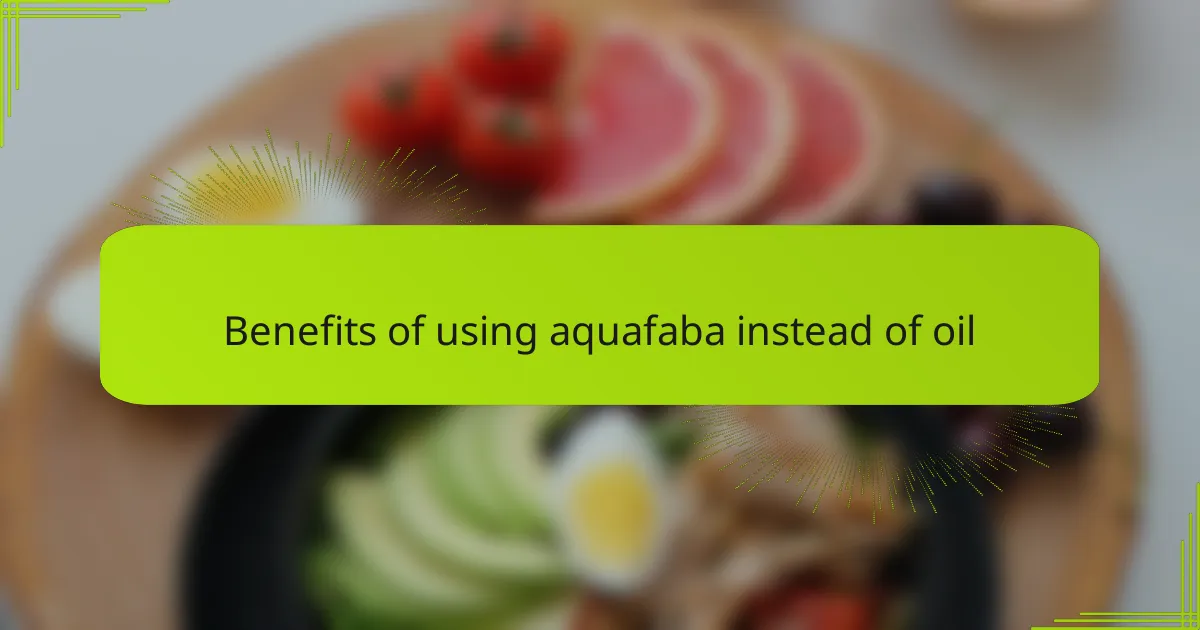Key takeaways
- Aquafaba, the liquid from cooked chickpeas, can replace oil and eggs in desserts, creating a lighter texture without compromising flavor.
- Using aquafaba significantly reduces fat content and adds moisture, resulting in airy, satisfying baked goods.
- The consistency and freshness of aquafaba impact the final dessert, with canned chickpeas often providing optimal results.
- Adjusting the liquid content and gently folding aquafaba into recipes are essential techniques for maintaining its unique texture in baking.

Understanding aquafaba in desserts
Aquafaba is essentially the liquid leftover from cooking chickpeas or other legumes, and it’s astonishing how this simple ingredient can mimic the properties of egg whites and oil in desserts. Have you ever tried whisking it into fluffy peaks? From my experience, it’s like magic watching something so overlooked transform the texture of cakes and mousses.
What makes aquafaba so fascinating to me is its versatility—it can add moisture, act as a binder, and even lighten the feel of baked goods without the heaviness oil sometimes brings. I often find myself experimenting with it when I want to create desserts that feel lighter but still maintain that rich taste and consistency.
Understanding aquafaba in desserts means appreciating its subtle power; it’s not just a substitute, but a way to rethink traditional ingredients. It made me wonder, why hadn’t I tried it earlier when it offers a vegan-friendly, lower-fat alternative without sacrificing flavor or structure?

Benefits of using aquafaba instead of oil
One of the biggest benefits I noticed when swapping oil for aquafaba is the dramatic reduction in fat content. I remember feeling lighter after enjoying desserts made this way, and that was a pleasant surprise—especially knowing I didn’t have to compromise on flavor or texture. Isn’t it incredible that something as simple as chickpea water can deliver moisture without all those extra calories?
Another advantage that struck me was how aquafaba brings a certain airiness to my cakes and brownies that oil often masks. I found this especially useful when making desserts that needed a delicate crumb or a fluffy mouthfeel. Have you ever wished your baked goods could feel less dense but just as satisfying? Aquafaba really made that possible for me.
Finally, I appreciate the added bonus of using aquafaba as a more natural, plant-based ingredient. In my kitchen, that means fewer processed oils and a cleaner ingredient list. It’s comforting to know that choosing aquafaba aligns with both my health goals and my desire to minimize artificial additives—something I think more home bakers might enjoy exploring too.

How aquafaba changes dessert texture
When I first replaced oil with aquafaba, I immediately noticed how it transformed the texture of my desserts. Instead of that dense, sometimes greasy mouthfeel oil can leave behind, aquafaba introduced a light, airy quality that made each bite feel almost weightless. Have you ever yearned for a cake so tender it almost melts on your tongue? Aquafaba helped me achieve exactly that.
What’s fascinating is how aquafaba creates a delicate crumb by trapping air during mixing, much like egg whites do. This change isn’t just cosmetic—it affects how the dessert feels when you eat it, giving a softness and fluffiness that oil rarely provides. I found this especially amazing when baking brownies; they became moist yet springy, rather than heavy and fudgy.
At times, I wonder if this unexpected shift in texture is why desserts made with aquafaba seem more satisfying without feeling overwhelming. The moisture it adds seems gentler, almost as if the dessert breathes. This subtle yet noticeable change made me rethink how texture can influence enjoyment, proving that sometimes less oil really does mean more pleasure.

Choosing the right aquafaba for recipes
Choosing the right aquafaba is surprisingly important to how your dessert will turn out. From my experience, the consistency matters—a thicker aquafaba from canned chickpeas tends to whip better and mimic the richness of oil more effectively. Have you ever tried using that watery liquid from other legumes only to find your batter too loose? That was my early mistake, and it made a noticeable difference.
I also found that the flavor of the aquafaba subtly influences the final taste. When I used aquafaba from plain chickpeas, it lent a neutral background that let other dessert flavors shine, but ones from seasoned or salted beans sometimes added unintended notes. It’s a detail I pay more attention to now because it shapes the whole outcome.
Finally, freshness plays a role that not everyone thinks about. I often prefer to use aquafaba straight from a newly opened can rather than homemade batches stored too long, since that fresher liquid gives me more reliable results. Have you noticed how sometimes your dessert turns out differently depending on how old the aquafaba is? That variability caught me off guard until I started selecting it more deliberately.

Step by step aquafaba substitution guide
First, I measure aquafaba carefully to replace oil on a 1:1 basis by volume. It took me a few tries to get comfortable with this—too little aquafaba and the batter felt dry; too much, and it became too loose. Finding that sweet spot was key to maintaining the right texture.
Next, I incorporate aquafaba gradually while mixing, watching how it emulsifies with other wet ingredients. This step feels a bit like magic; aquafaba binds everything together without the slick heaviness I usually get from oil. Have you ever noticed how your batter changes in consistency mid-mix? That’s aquafaba working its wonders.
Finally, I adjust my baking times slightly since desserts with aquafaba tend to bake faster due to the extra moisture. Early on, I learned not to rush this step—checking with a toothpick regularly helped me avoid overbaking. This small change made all the difference between a dry dessert and one that’s perfectly tender.

Personal tips for baking with aquafaba
When I started baking with aquafaba, I quickly realized that whipping it just right makes all the difference. Achieving those soft, billowy peaks takes patience, but once you get there, you’ll notice your batter lightens beautifully. Have you ever been surprised how a simple change in technique can elevate an entire recipe? That was definitely a turning point for me.
One tip I swear by is to reduce or skip other liquids slightly when using aquafaba instead of oil. Since aquafaba adds moisture, not adjusting can lead to a batter that’s too runny. Early on, I learned this the hard way when my cakes didn’t set properly—but once I tweaked the recipe, everything fell into place.
Also, I found that folding aquafaba gently into the dry ingredients preserves its airy texture much better than vigorous mixing. It feels counterintuitive, especially for someone used to blending batters quickly, but this gentle approach keeps the lightness intact. Hasn’t it amazed you how small changes in mixing styles can impact the final crumb? For me, it’s a game-changer every time.

Delicious dessert recipes using aquafaba
Delicious dessert recipes using aquafaba truly opened up a whole new world for me. One of my favorites is a chocolate mousse where aquafaba replaces both oil and eggs—watching it whip into glossy peaks felt so rewarding, and the end result was surprisingly light yet decadently rich. Have you ever experienced a mousse that’s both airy and satisfying without that heavy, oily aftertaste? Aquafaba made that happen in my kitchen.
I also experimented with lemon cakes swapping oil for aquafaba, and the citrus notes really shone through with a tender crumb that didn’t feel dense or greasy. It was a pleasant surprise to bite into something so moist yet refreshingly light. If you’ve wondered how to make springy, fluffy cakes without using a drop of oil, this trick might just change your baking game.
Then there’s the classic brownie—usually rich and fudgy with oil, but when I tried aquafaba, the texture became springy and almost bouncy in a way I hadn’t expected. It made me question all my previous dessert experiments. Could this humble chickpea water really deliver that perfect balance of moistness and lift? For me, the answer is an enthusiastic yes every time I bake.




